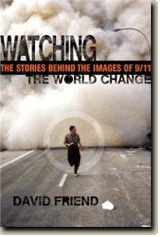« Previous · Home · Next »
April 26, 2009
A WEEK IN THE LIFE OF THE PHOTOGRAPH
When I originally conceived the book that would become Watching the World Change, my working title was "9/11: A Week in the Life of the Photograph." And one of the reasons that I wrote the book in the first place was to prove a simple thesis. In this age of imagery, I believed, one could take the DNA of any slice of history (a year, a month, even a day) and begin to understand its essence through the photographs that it generated. Watching the World Change, in fact, traces the week of September 11-17, 2001, by examining the meaning behind the mosaic of pictures taken over that pivotal seven-day span.
I was struck by the resonance of this thesis when I realized the significance of several caches of photographs - all making their way onto the public radar this week - that are essential to how future historians will be able to gauge the American mindset when looking back at the Spring of 2009.
First, hundreds of pictures, taken by American combatants during the war in Iraq, are set to be released this week by the Obama administration. The images, showing torture of detainees in U.S. custody, will be used as evidence to support the assertion that the Abu Ghraib prisoner-abuse photographs did not represent isolated incidents perpetrated by a few rogue elements but were part of an overarching policy green-lighted at the highest levels of the Bush administration.

Second, President Obama will complete his 100th day in office this week. And that benchmark brings to mind the historic project, Let Us Begin: The First 100 Days of the Kennedy Administration, an exhaustive pictorial survey (with a lead photo-essay by Cornell Capa) of the state of the nation in 1961, a portfolio that Capa’s photo agency, Magnum, produced as a latter-day version of the Farm Security Administration’s famous photo-documentation of Depression-era America.
In that same tradition (and with much more hype on the part of the media), news organizations are marking Obama’s milestone with photographs. Time magazine has already come out with its 100-Day photo essay, by Callie Schell, in its new issue, out Friday. Time also offers an expanded and remarkably intimate selection of 77 pictures on its Website. Slate.com has posted a link to many of the best shots that White House photographer Pete Souza has taken during the past three months. And a group of top photographers, working with the official presidential inaugural committee, are releasing a new commemorative volume, Barack Obama: The Official Inaugural Book, timed to coincide with the 100 Day watershed. (An exhibition of images from the book will open at the Smithsonian, in Washington, on May 13.)

Finally, the Jet Propulsion Lab has just released the most high-resolution images ever made available of the Saturn and its rings and moons, all taken from the Cassini spacecraft, which has been orbiting the planet since 2004.

Images of brutality, of history, of wonder. In this voyeuristic era, how are we to understand the events and discoveries of our times unless we take a long, hard look at the visual goods?


